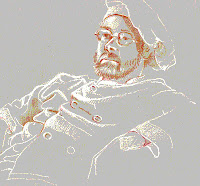If this page looks familiar, it's because it was posted for a couple of hours by mistake just last week. Sorry!
I think I've mentioned the fact that my drawing group has had relatively few men as models but Dan was one who was frequently on the stand several years ago. I show these particular drawings to point out a couple of ways to use white pencil on toned paper and to explore some subsequent creative moves. In most of my drawings where white pencil is involved I've worked with contour line then added white lights. These two are a bit different.
In this first informal portrait sketch the white is used as reflected light that defines the smooth shiny skin of his forehead and gives us an overall sense of three dimensional form. This in turn contributes to our comprehension of the figure as "real", standing out from an indeterminate background and acts as evidence of something just out of sight - perhaps light from a window - a contribution to atmosphere or story.
The second drawing is a bit more abstract, more graphic. The over-all "feel" of the picture is softer, more laid-back than the portrait above with its black bristly beard. The white still illuminates the forms involved but rather than necessarily being realistic we see it more as shape and edge with the grey toned paper doing double duty as background and mid-tone skin and fabric. If we were designing something like a serigraph, a silk-screen print in which color would typically be flat without gradation, this drawing could serve as an initial step. In such a print it could lose some of its soft delicacy but the tension of background vs. foreground would still work.
Here are a couple of variations via Photo Shop: one on the left with increased color saturation, a second with high contrast, the third with all color removed - just black & white (really grey) variations so softer still. I could go on with a dozen iterations but suffice to say it's a good way to test the "what if" question before actually doing a second color drawing, painting or for actual use in making a print.


Now, having said all that I realize we are going in a direction that violates or at least bends one of my first principles, the concept of art - drawing in particular - as hand-made. You know I always speak of the hand of the artist as an important aspect obvious in the work but once you cross over into reproduction, whether mechanical, photographic or digital - that may not apply at all.
Think about that!
"There is no best way to make art, but there are a lot of better ways." Darby Bannard
"Art and science have their meeting point in method." Edward G. Bulwer-Lytton
"The abstract nature of reality is the source of beauty." William De Raymond














